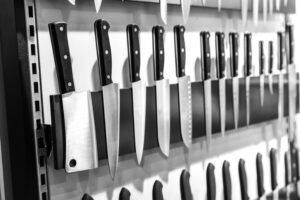Sharpen Your Knives Like a Chef: Simple Techniques for Razor-Sharp Blades
A sharp knife is an essential device in any kitchen, allowing you to slice, cube, and chop with precision and simplicity. However, even exceptional knives can become dull with regular use over time. Fortunately, sprucing your knives would no longer be a frightening mission reserved for professional cooks. With the right strategies and tools, you may sharpen your knives like a pro and preserve razor-sharp blades for all your culinary endeavors. In this manual, we can discover smooth techniques for polishing your knives at home, ensuring they will be usually equipped to address any reducing assignment with precision and performance.
Understand Knife Anatomy
Before diving into polishing strategies, it’s vital to understand a knife’s anatomy. A typical knife consists of a blade, a lowering area, a backbone, and a manipulation. The decreasing aspect is the sharpened part of the blade that makes touch with meals, while the spine is the thicker, unsharpened portion that gives balance and energy. Familiarizing yourself with the additives will help you sharpen your knives correctly and properly.
Choose the Right Sharpening Tools
There are numerous kinds of sprucing equipment to be had, each designed for different ranges of polishing and preservation. The most commonplace sprucing equipment encompasses:
- Sharpening Stones: Sharpening stones, also called whetstones, are flat, square blocks of abrasive fabric used to sharpen knife blades. They are available in several grits, from coarse to quality, permitting you to alter the sprucing based totally on your needs.
- Manual Knife Sharpeners: Manual knife sharpeners are handheld gadgets that feature abrasive surfaces, such as ceramic rods or diamond-coated plates, to sharpen knife blades. They’re smooth to use and suitable for retaining knife edges between polishing intervals.
- Electric Knife Sharpeners: Electric knife sharpeners are motorized devices that use rotating abrasive belts or grinding wheels to sharpen knife blades quickly and effectively. They’re first-class for busy kitchens or customers who choose a fingers-off polishing technique.
- Honing Rods: Honing rods, referred to as sharpening steels, are lengthy, narrow rods crafted from ceramic, metal, or diamond-coated metallic. They’re used to realign and maintain the brink of a knife blade amongst sprucing intervals, in preference to sharpening it.
Choose the polishing device that suits your dreams, charge range, and degree of information.
Master the Sharpening Technique
Once you have decided on your polishing tool, it’s time to master the polishing technique. Here’s a step-by-step manual to sharpening your knives like a chef:
Prepare the Sharpening Surface: Place your sprucing stone or manual knife sharpener on a solid floor, such as a countertop or slicing board. Ensure the surface is easy and particles-free to prevent interference with the sharpening approach.
Determine the Angle: The attitude at which you hold the knife towards the polishing floor is essential for accomplishing closing consequences. The perfect sharpening perspective varies depending on the form of the knife and personal desire, but it typically involves 15 to 20 stages for maximum kitchen knives.
Hold the Knife Properly: Grip the knife firmly to cope with the blade going far away from you. Place the heel of the blade opposite the sharpening floor from the desired perspective, ensuring consistent strain and getting in touch with the entire blade length.
Begin Sharpening:
With a steady hand, draw the knife blade at some point on the sharpening floor, transferring from the heel to the top in an easy, controlled movement. Apply light to slight pressure and maintain a constant attitude throughout the sharpening process.
Repeat on the Other Side: After several passes, turn the knife over and sharpen the other side using the equal approach. Aim for various passes on each component to ensure a balanced facet.
Test the Sharpness: Once you have sharpened each aspect of the blade, carefully check the sharpness by gently reducing it through a chunk of paper or a ripe tomato. A nicely sharpened knife must be cut with minimum effort and without tearing or crushing the food.
Hone the Edge (Optional): If desired, use a honing rod to realign and smooth the brink of the blade between polishing classes. Hold the honing rod vertically in the direction of the knife’s slicing-edge and draw the blade across the rod in a sweeping movement, repeating numerous times on each aspect.
Practice Proper Maintenance
In addition to normal sprucing, the right renovation is critical for maintaining your knives in top condition. Here are some hints for retaining sharp knives:
Properly Store Knives: Store knives in a knife block, magnetic strip, or sheath to protect the blades from harm and prevent dulling.
Avoid Cutting on Hard Surfaces: Avoid reducing on difficult surfaces, including glass, granite, or ceramic, as they can stupid knife blades quickly.
Hand Wash and Dry Thoroughly: Always wash your knives with moderate cleansing soap and warm water, and dry them well with a clean towel to save you rust and corrosion.
Use a Cutting Board: To protect the blade and lengthen its sharpness, use a slicing board manufactured from timber, plastic, or bamboo.
By working towards proper preservation conduct, you may extend the life of your knives and ensure they continue to be sharp and effective for many years.
Seek Professional Assistance When Needed
While polishing your knives at home can be a profitable and value-effective organization, there may be instances when it is satisfactory to seek expert help. If you’re uncertain about the sharpening method or have knives with large harm or put on them, take them to an expert knife sharpener for professional care and healing. Professional sharpeners have the experience, tools, and records to evaluate the scenario of your knives and offer the right sprucing and upkeep offerings.
Conclusion
Sharpening your knives like a chef is a treasured skill that could beautify your culinary revel and make meal coaching more interesting and inexperienced. By information knife anatomy, selecting the proper sprucing device, studying the polishing approach, running towards the right protection, looking for professional help while desired, and following the often-asked questions and solutions, you will be well-geared up to preserve your knives sharp, secure, and prepared for any reducing assignment that comes your manner. With a touch exercise and endurance, you’ll be quickly lowering, dicing, and cutting like a seasoned.
FAQs
-
How regularly ought I sharpen my knives?
The frequency of sprucing is based on how frequently you use your knives and the sort of slicing responsibilities you carry out. As a good-sized rule, knives used regularly in a domestic kitchen may require sprucing every 3 to six months. However, knives used much less frequently or for lighter duties can be best spruced once or twice every 12 months.
-
Can I use a sprucing metal instead of a sprucing stone?
Yes, sharpening steel, also known as a honing rod, can be used to maintain a knife’s edge amongst polishing instructions. However, polishing steel does not sharpen the blade but realigns and smooths the edge to hold it sharp. A sharpening stone or other abrasive sprucing device is necessary for dull knives to repair the threshold.
-
How do I understand while my knives need sprucing?
You can tell at the same time that your knives want sprucing by reading the reducing facet for symptoms of dullness or damage. Dull blades can also feel less effective at cutting through meals, requiring extra effort and stress to reap smooth cuts. Additionally, you may see nicks, chips, or bends alongside the decreasing aspect, indicating the need for sharpening.
-
Can I use a manual knife sharpener for serrated knives?
While guide knife sharpeners are appropriate for sprucing right now-edged knives, they’re no longer encouraged for serrated knives. Serrated knives have a unique blade form with scalloped or teeth-like edges that require specialized polishing tools. To sharpen a serrated knife nicely, use a sprucing rod designed specifically for serrated blades or if you are looking for expert help.
-
What’s the awesome angle for polishing knives?
The perfect sharpening attitude depends upon the shape of the knife and its supposed use. A sharpening attitude of 15 to 20 degrees is recommended for most kitchen knives. Thinner blades, including those on Japanese-fashion knives, may benefit from a decreased attitude, while thicker blades, such as those on cleavers or searching knives, may additionally require a slightly higher altitude.
-
Can I sharpen ceramic knives at domestic?
While ceramic knives are considered durable and sharp, they require specialized polishing gadgets and strategies because of their brittle nature. It’s remarkable to avoid sprucing ceramic knives at home, and alternatively, they are looking for expert assistance from a knife sharpener professional who works with ceramic blades. Professional sharpeners have the know-how and equipment to sharpen ceramic knives accurately and correctly.
-
Can I use a leather-based strop to sharpen my knives?
A leather-based, primarily based strop may be used to refine and polish the threshold of a knife after sprucing; however, it is not appropriate to spruce stupid blades. Leather straps are generally used alongside abrasive compounds or honing pastes to achieve a replicate-like end on the reducing side. For polishing stupid knives, use a polishing stone or distinct abrasive sprucing tool to repair the brink earlier than completing with a leather-based totally strop.
-
How do I keep the sharpness of my knives in polishing classes?
To keep your knives sharp between polishing classes, use a honing rod or sprucing metal to realign and ease the threshold of the blade. Regularly hone your knives before or after each use to keep them acting at their satisfactory. Additionally, exercise proper knife management and garage behavior to save you harm and dulling, such as using a slicing board and storing knives in a knife block or sheath while no longer in use.
